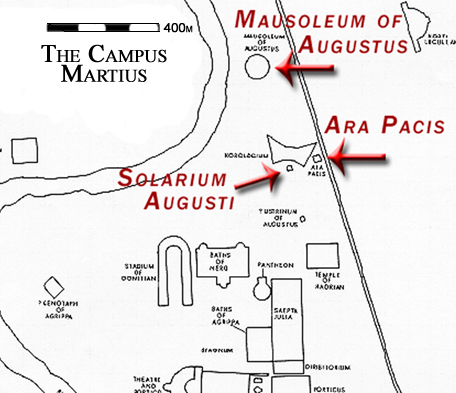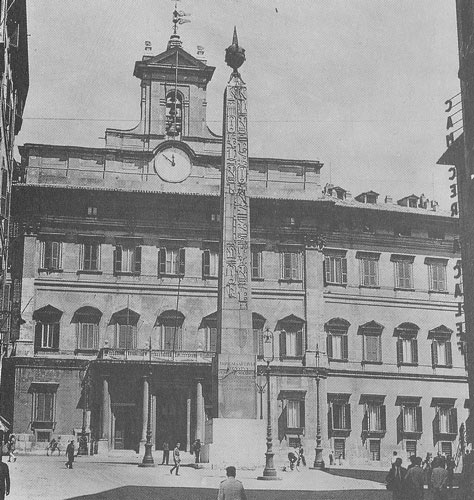Historical and Location Facts
The Ara Pacis, or Altar of Augustan Peace, was decreed by the Roman senate to honor the return of Caesar Augustus from his conquest of the province Spain. Augustus returned from his three year military tour of Spain and Gaul on the evening of July 3, 13 BC. (He chose to enter the city during the night to avoid the necessity of a large welcoming celebration) On July 4, the Senate voted to create the Ara Pacis to commemorate his safe return. The Ara Pacis was completed and dedicated on January 30, 9 BC (Galinsky 141-2). The Ara Pacis sits in the northern end of the Campus Martius. Augustus had the altar placed near his already constructed mausoleum. The whole northern portion of the Campus Martius was built up into a very scenic and pleasant park.
Historical Text References
Res Gestae Chapter 12.2 (Cooley 30)
When I returned from Spain and Gaul, in the consulship of Tiberius Nero and Publius Quintilius, after successful operations in those provinces, the Senate voted in honor of my return the consecration of an altar to Pax Augusta in the Campus Martius, and on this altar it ordered the magistrates and priests and Vestal Virgins to make annual sacrifice.
Ovid's Fasti 1.709-722 (Cooley 233)
Unaided to Peace's Altar has my song guided my footsteps;
From the month's ending this will be the day penultimate.
Come Peace, your comely tresses decked with laurel leaves
Of Actium, come and over all the globe sustain your gentle sway.
As long as Rome lacks enemies and her generals a source of triumphs,
So long will you to generals afford a glory greater than any war.
Let Roman soldiery bear arms only to curb the arms of enemies;
And for no cause save only ceremony let savage war-horns sound.
Let the wide world's shores from first to last be fearful of the sons
Of great Aeneas. Where they fear too little, let them feel love.
Come priests, add incense to the flames of peace; come, pour wine
Upon the victim's pure white head and let it fall. Pray to the gods,
Who hearken always to our pious prayers, that Caesar's house,
The guarantor of peace, in peace may live for ever.
The Campus Martius with the Ara Pacis in its original location.
Solarium Augusti
Directly next to the Ara Pacis is the colossal sundial known fittingly as the Solarium Augusti. Whereas the altar was a tribute to Augustus’ triumph in Spain and Gaul, the gnomon (needle) of the sundial was an obelisk imported from Egypt, a tribute to Augustus' subjugation of Cleopatra and the Egyptian nation. The obelisk most prominently has a globe sitting upon the apex that represents the world dominance that Augustus brought to Rome. The ground below was marked with bronze lines that indicated various dates and months of the Roman calendar. On September 23, both the autumnal equinox and the birth date of Augustus, the shadow of the obelisk was cast directly to the center of the Ara Pacis. This coincidence served to reinforce that Augustus was intrinsically connected with the Pax Romana and the perception that Augustus was “born to peace, natus ad pacem” (Galinsky 146).
The Ara Pacis Through the Ages
The altar suffered during the middle ages with many of the faces of the depicted persons being destroyed and replaced with contemporary impressions. Work was done in the 18th century to restore the missing visages. Several slabs of the Ara Pacis were recovered in 1568, 1859, and 1903. In 1937-8, Mussolini had the area around the Ara Pacis excavated and reconstructed within a memorial dedicated to the feats of Augustus.
Artist's rendition of the Solarium Augusti.
The Egyptian obelisk from the Solarium Augusti as it stands today in front the Italian capitol building. Notice the globe upon its apex that represented the world domination of Rome brought on by Augustus.



